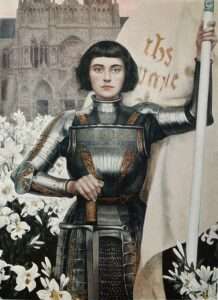Exploring the Heroine’s Historic Journey
When it comes to historical figures, few have left an indelible mark on the pages of history like Joan of Arc. Her story is one of courage, faith, and determination, making her an inspiration to people around the world. And what better way to discover the life of this legendary figure than by embarking on a private tour guide.

Joan of Arc- Historic Journey Private Tour
Enjoy a custom-made private tour guide with private driver about Joan of Arc from Paris to Normandy. Have a stop at Rouen, to The Loire Valley from Paris with Orléans. Discover the region of Champagne from Paris as well, where took place the coronation of Charles VII thanks to Joan in the iconic Reims Cathedral.
A brief overview of Joan of Arc
Born on the border of the Lorraine and Champagne regions, Joan was the daughter of a farmer from Domrémy, Jacques D’Arc and Isabelle Romée. Joan of Arc, known as “the Maid”, born around 1412 and died at the stake on May 30, 1431 in Rouen, capital of the Duchy of Normandy then an English possession.
Joan of Arc is a heroine in the history of France, warlord and saint of the Catholic Church, posthumously nicknamed “the Maid of Orléans”. She is in many countries a mythical personality who has inspired a multitude of literary, historical, musical, dramatic and cinematographic works.
Joan of Arc’s call
In 1415, when Joan was three, the English king, Henry V, taking advantage of a civil war between the Dukes of Orleans and Burgundy, invaded Normandy and claimed several cities. Things were going from bad to worse for France when, in the village of Domremy, God began to put in motion a most unexpected solution.
At the beginning of the 15th century, this young girl of peasant origin affirmed that she had received from Saints Michael, Margaret of Antioch and Catherine of Alexandria the mission of delivering France from English occupation.
This was the situation in which Joan left Vaucouleurs in February 1429. She managed to cross enemy lines and reached Chinon in 11 days. She met Charles VII there twice. Joan told him that her “mission” was to free Orléans, besieged by the English, and take him to Reims to be crowned king.
Leading Armies to Victory in Orleans
Ultimately, after extensive debriefing and debate, Joan was outfitted with armor, sword and a white-gold standard. It was bearing the names of Jesus and Mary, and an image of God the Father and angels offering Him a Fleur-des-Lys, the symbol of France. In the company of the Duke of Orleans, other French nobles, and their armies she freed the besieged city of Orleans. To everyone’s amazement, Joan proved an effective general and strategist, though she never personally killed a man.
In fact, she manages to lead the French troops victoriously against the English armies, to raise the siege of Orleans and to lead the king to the coronation, in Reims, thus contributing to reverse the course of the Hundred Years’ War. The coronation took place on 17th July 1429. Charles VII was now a rightful King of France. Joan continued to fight in the army until she was captured in Compiègne in May 1430.
Joan of Arc in Paris
Paris, her first defeat after Orleans
After leading her great victorious expedition which led to the liberation of Orléans from the English siege and led Charles VII to be crowned at Reims, Joan of Arc continued her campaign. She then wanted, in the fall of 1429, to retake Paris which was in the hands of the English and the Burgundians. Indeed, Paris was then in the hands of the Burgundians of Philip the Good and indirectly of the English.
However, Joan of Arc had great difficulty in truly bringing her generals with her. Also, to set an example, she went to expose herself directly, under English fire. As a result, she was injured very quickly. On September 8, 1429, Joan of Arc suffered her first defeat under the ramparts of Paris. That day, she was seriously hit by a crossbow bolt. She can live with this injury.
In the footsteps of Joan in Paris
-
Saint Denys de la Chapelle
The French knights found themselves in the shelter of the Chapelle Saint Denis. Indeed, in the night of September 7 to 8th 1429, Joan went to this church for a vigil with some captains. It is said that she did pray on the right of the entrance next to the second pillar. This church is dedicated to Saint Denis first bishop of Paris around 258. Before the actual building, Saint Geneviève, Sainte Patronne of Paris from the V century built a first church at the same place dedicated to Saint Denis. During the French revolution, the church lost part of its Cultural Heritage.
-
Saint Joan of Arc Basilica
Next to Saint Denys de la Chapelle, Abbey Margand during his preaching of September 6th 1914 make the wish to build this basilica if the Germans do take over Paris. The basilica was solemnly inaugurated on May 10, 1964 by Monsignor Pierre Veuillot under the presidency of Monsignor Maurice Feltin, Archbishop of Paris, 50 years later.
-
Montmartre
On the top of the hill, Joan of Arc with her army captains observed Paris : The Louvre with its parapets from King Philippe Auguste. Moreover, she could see Notre Dame Towers. She also saw Mont Sainte Geneviève next to the actual Pantheon and Saint Etienne du Mont church holding the relics of Sainte Geneviève. They decided from the top of Montmartre to reach Paris from Saint Honoré Doors. Joan reached the top of Montmartre probably from the Abbesses Square, Benedictines abbesses of the previous abbey (the building does not exist anymore) close to Saint Pierre de Montmartre church.
-
Saint Honoré Door 161-165 rue Saint-Honoré
At this place, the suffering of her bruised flesh seems futile to her compared to the great disappointment she has at having to abandon the fight to conquer the capital. She also feels bitterness towards the decision of the king, who is about to put an end to her “divine mission”. A commemorative plaque is placed at 163 rue de Saint-Honoré, Paris 1st, with a relief of Joan of Arc by Maxime Real del Sarte. “Here stood the Porte Saint-Honoré near which Joan of Arc was wounded on September 8, 1429”. The Saint Honoré Door came from King Charles V parapets. Indeed, the Porte Saint-Honoré is a missing gate in Paris. There were successively three Portes Saint-Honoré, as the various city walls were extended, staggered along the Rue Saint-Honoré. They were destroyed one after the other to facilitate supplies and traffic in Paris.
-
Place des Pyramides Joan of Arc Statue
The Monument to Joan of Arc is an equestrian statue of Joan of Arc made by the French sculptor Emmanuel Frémiet. Inaugurated in 1874, it is located on Place des Pyramides, in the 1st arrondissement of Paris.
On May 30, 1431, Joan of Arc died at the stake
Compiègne
The Siege of Compiègne was a military operation carried out by the Burgundian army from May 20, 1430 to October 28, 1430, in an attempt to take the city. Joan of Arc was taken prisoner during this siege. She was bought by the English for 10,000 pounds, then entrusted to Pierre Cauchon, Bishop of Beauvais, who collaborated with them (Joan was captured in the diocese of Beauvais).
Trial
Unfortunately, Captured by the Burgundians at Compiègne in 1430, she was sold to the English by Jean de Luxembourg, Count of Ligny, for ten thousand pounds. Joan answered her accusers with patience and poise, some would say with nerve. She was found guilty of “heresy, apostasy and idolatry” and burned at the stake on 30th May 1431 on Place du Vieux Marché at Rouen. She will not have the privilege of being strangled before going to the stake and will find death in the flames. Joan was 19 years old.
Review Trial
Actually, review trial took place in 1456-1457 and exonerated her of her supposed “crimes“. She was condemned to be burned alive in 1431 after a trial for heresy led by Pierre Cauchon. He was the bishop of Beauvais and former rector of the University of Paris. Tainted by numerous irregularities, this trial saw its revision ordered by Pope Calixte III in 1455. A second trial was held which concluded, in 1456, that Joan was innocent and completely rehabilitated her. Thanks to these two trials which have been preserved, she is one of the best known personalities of the Middle Ages.
Joan canonized
Thus, beatified in 1909 then canonized in 1920, Joan of Arc became one of the two secondary patron saints of France in 1922 by the apostolic letter Beata Maria Virgo in cælum Assumpta in gallicæ. Its national holiday was instituted by law in 1920 and fixed for the 2nd Sunday in May.
Joan of Arc and the Church
Pius II, by his birth name Enea Silvio Piccolomini, is in literature by his Latin name Æneas Sylvius. He was born October 18, 1405 in Corsignano, in the Republic of Siena and died August 15, 1464 in Ancona. He was the 210th Pope of the Catholic Church (from August 19, 1458 to August 14, 1464). Pope Pius II spoke of Joan of Arc in these terms:
“… Thus died Jeanne, the admirable, the stupefying Virgin. It was she who raised the kingdom of the dejected and almost desperate French people, she who inflicted on the English so many and such great defeats. At the head of the warriors, she kept a spotless purity in the midst of the armies, without the slightest suspicion ever having touched her virtue. Was it divine work? was it a human ploy? It would be difficult for me to say so. Some think that during the prosperity of the English, the nobles of France being divided among themselves, without wanting to accept the conduct of one of their own, one of them better advised will have imagined this artifice, to produce a Virgin divinely sent, and as such claiming the conduct of business; there is not a man who does not accept having God as head; thus the direction of the war and the military command were handed over to the Maid. What is well known is that, under the command of the Maid, the siege of Orleans was lifted; it is that by his arms the whole country between Bourges and Paris has been subjugated; it is that, by his council, the inhabitants of Rheims returned to obedience and the coronation took place among them; that, by the impetuosity of his attack, Talbot was put to flight and his army cut to pieces; by his audacity the fire was set at a gate of Paris; by his penetration and skill the affairs of the French have been solidly restored. Events worthy of memory, although in posterity they must excite more admiration than they will find credence. »
Joan of Arc’s extraordinary journey is a testament to the strength of human spirit and the power of conviction.
Orleans in the Loire Valley and Joan of Arc
Orleans, nestled in the picturesque Loire Valley of France, is a city brimming with history, culture, and charm. It is approximately 130 kilometers (80 miles) south of Paris. Joan of Arc played on May 8, 1429 a decisive role in the liberation of the city occupied by the English. Expect to see her proudly erect on her horse on the beautiful Place du Martroi. You can also find her in the cathedral and in the halls of the Town Hall. You can also see her engraved on the nails that mark the pedestrian crossings or painted on the coffee cans or cotignac… Jeanne d’Arc is also present – in flesh and blood this time – at the beginning of May, for the Johanniques celebrations who pay tribute to her every year.
The House of Joan of Arc
It is in Orleans a Historical Museum. It houses the largest documentary collection devoted to Joan of Arc. Joan of Arc’s house is a half-timbered house. It is a reconstruction from the 1960s of the residence of Jacques Boucher. He was general treasurer of the Duke of Orléans. He housed Joan of Arc from April 29 to May 9, 1429 during the siege from Orleans.
Restructured and modernized, the House of Joan of Arc offers visitors: On the ground floor, a multimedia room broadcasting a panoramic film on the Hundred Years War. In addition, the life of Joan of Arc and her memory in Orléans with terminals interactive displays. It is an illustrated chronological frieze and a cartography of the epic of Joan. Upstairs, the Joan of Arc center, the largest documentary collection dedicated to Joan of Arc and her time: 37,000 documents (books, magazines, postcards, engravings, posters, films, objects, etc.).
Sainte Croix Cathedral and Joan of Arc
At Orléans Cathedral, witness the captivating stained-glass windows that depict Joan’s journey. Admire the grand statue erected in her honor, commemorating her indomitable spirit.
It took 600 years to built this cathedral. From the 13th to the 19th centuries, Orléans Cathedral bears the imprint of the royal successions. Joan of Arc prayed there, Henri IV launched its reconstruction in 1601, Louis XIV financed the transepts which pay homage to him by displaying his motto and his sun. The magnificently woodwork of the choir, the glass windows telling the story of Joan of Arc are among its ‘treasures’, as are the 11 richly 13th century chapels which form its chevet. Sainte Croix cathedral is one of the 5 largest Gothic cathedrals in France (140m long, 53m wide with a spire culminating at 106m), Sainte-Croix construction begun in 1287 and official inauguration on May 8, 1829.
Place du Martroi
It was the place where the condemned were executed. Moreover, it served as a wheat market. The city integrated this square during the construction of the second enclosure in the 14th century. Some vestiges of the Porte Bannier are still visible in the car park under the square.
Place du Martroi is today the most important place. It marked by the equestrian statue of the Maid inaugurated on May 8, 1855. The statue is the work of the sculptor Foyatier and represents Joan of Arc giving thanks to God. Place du Martroi is the main square in downtown Orléans. It is classified as a Historic Monument.
Indeed, the “City of Joan of Arc” is Orleans. It is located along the banks of the majestic Loire River. With a history dating back to Roman times, it also has evolved into a vibrant metropolis while retaining its rich heritage.
Castles of the Loire Valley near Orleans
Moreover, enjoy castles visit. Here are 5 Loire castles to visit around Orléans for their gardens, architecture and history :
-
Le Château de Meung-sur-Loire (35 minutes drive from Orleans)
Meung Castle was the residence of the bishops of Orléans and hosted great names in French history. Moreover, Meung Castle was also a strategic location. Indeed, the conflict between the English and the French during the Hundred Years’ War took place here. Joan of Arc delivered it after her victory at Orléans. Bought during the Revolution by one of the founders of the Bank of France, Meung Castle has been a private residence open to visitors for several years.
-
Le château de la Ferté-Saint-Aubin (20 minutes drive from Orleans)
It is less than 20 minutes from Orléans and 30 minutes from Chambord. The family Château de la Ferté Saint Aubin offers new ways to visit a castle. This family castle, private and inhabited for 350 years, is a setting within a 50-hectare park. This castle welcomes each visitor as a patron, a friend of Heritage. Indeed, for 30 years, little by little visitors restored the castle. The entry price corresponds to the purchase of 5 slates!
-
Le Château de Chamerolles (35-40 minutes drive from Orleans)
Built at the dawn of the Renaissance in Chilleurs-aux-Bois, this estate remained in the family for 235 years. Its architecture evolves over time with successive owners. The French Revolution and the two world wars were periods of destruction or ransacking for the castle. Surrounded by a park, a lake and a Renaissance garden, the exterior of the castle invites the visitor on a bucolic stroll in a green setting. You too can discover our collection of 75 varieties of rose bushes. Endulge in their vegetable gardens and our environment conducive to walking.
-
Le Château de Chambord (50 minutes drive from Orleans)
Placed in the first list of Historic Monuments in 1840, Chambord is one of the most astonishing Renaissance constructions. Far from being a residential palace or even a hunting lodge, Chambord embodies a true utopia. A brilliant work of art which has not finished revealing all its secrets. From the moment you cross the surrounding wall, 32 kilometers long, you enter the heart of a world apart. You find yourself facing the genius architecture imagined by François I and the inspiring artist Leonardo da Vinci.
-
Le château de Sully-sur-Loire (45 minutes drive from Orleans)
Maximilien de Béthune, Duke of Sully, is the emblematic character of the Château de Sully-sur-Loire. Marshal of France, he was a Protestant soldier and a comrade-in-arms of King Henry IV. He became one of the main advisors. Philippe-Auguste, Louis XIV, Joan of Arc, Voltaire, La Fayette; the Château de Sully-sur-Loire has been the setting for many meetings.
Visit the Loire Valley in France for its magnificent castles, boasting stunning gardens, remarkable architecture, and rich historical significance.
Beyond Joan of Arc- Historic Private Tour Guide
PARIS BY EMY offers customizable Paris tour packages that allow you to combine different types of experiences.
You can also personalize the tours to focus on specific themes or leisure activities, tailoring the experience.
Emy,

